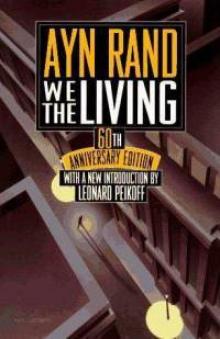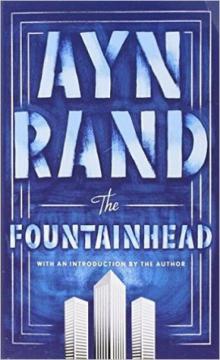The Journals of Ayn Rand Read online
Page 40
The rational faculty can neither be shared nor added. It does not grow by addition. It has a singular, but no plural. Men can unite their physical force, but not their brain power. Two young boys can join their strength to lift a weight, and their combined strength will equal approximately that of an adult man. Two half-wits do not equal one intelligent man. Nor do two intelligent men united produce an entity of double intelligence. The combined physical power of a group of ten average men is ten times that of each member of the group. The combined mental power of a group often average men is exactly that of the most intelligent member of the group—and no higher. The rational faculty has no plural.
Even the addition of men’s physical power is possible only in a few instances of its many applications—such as in lifting weights or in destroying and smashing things. If a group of men were lined up and ordered to run a race together, as a collective, maintaining a united front or unbroken line throughout—their combined speed would not equal the sum of their individual speeds, nor even the speed of the fastest man among them, but that of the slowest. Their collective effort would not lift them to the level of the best, but reduce them to the level of the worst. The lowest common denominator is always just that—the lowest.
If a group of men were ordered to solve an intellectual problem together, as a collective, acting in unison, taking no step without common assent and understanding—their combined effort would not equal the capacity of the best brain among them, but of the dullest. And, as a matter of fact, the actual result—if any—would be somewhere below the result produced by the dullest one working on his own; because, left alone, he would be unhampered.
Thousands of years ago, one man, somewhere in a forgotten jungle, looked at trees and thought of gathering their branches into the shape of a hut for shelter. Others saw his work and copied it. Their descendants inherited the hut. One among them thought of planting posts upright to support horizontal beams. The hut became a house. The post-and-lintel house became the Parthenon. Men discovered the principle of the arch—and the Parthenon became the Pantheon. Men discovered the principle of the flying buttress—and the Pantheon became the Rheims Cathedral. Men learned to make structural steel—and the Rheims Cathedral became the Empire State Building. But all through the process, what men inherited from other men was only the product of their thinking. The moving force in the process—the determining force—was man’s rational faculty that took the product as material, used it and originated the next step.
In each new step, the achievement was not that of the originator’s predecessors; their achievement had been there before; the part of a newly created object which constituted an achievement was not that which had been known before, but that which had not been known; not what the achievement was based on, but what had been added to that base. It was not the inventor of the hut who made the skyscraper possible—he made the hut possible; nor was it the designer of the Parthenon, nor any of the men who left their achievements to their heirs. The skyscraper was made possible by the thought of the man who designed it—to the exact extent to which the thought was new, i.e., his own.
In any period of mankind’s progress, the credit for what is done does not belong to a collective achievement of the past. First, it was not a collective achievement, not the group production of a group working as a group—but an aggregate of single, specific achievements by single, individual men. Second, even if viewed vaguely and inaccurately as a “collective achievement” in the sense of representing a sum, the past achievements in any period are just that: past. They are done, finished, completed—inert. What is done from then on, what is added to them, what is discovered, defined, invented, created for the first time in what constitutes the achievement. The credit belongs to the man who made the new step.
No matter how many steps were taken to reach any stage in the development of any particular human product, no matter how many men perfected single details—each step was the work, the creation and the achievement of some one individual man. Someone had to think of it.
If several men thought of it simultaneously, as when inventors make similar discoveries independently of one another, it still remains true that each had to arrive at his conclusion through a rational process of his own. An argument such as “If Columbus hadn’t discovered America, somebody else would have,” is pointless and meaningless. Yes, somebody else would have—if he had acted as Columbus did, i.e., if he had ventured out on an untried journey guided by an idea of his own, unshared and unsanctioned by the majority of his contemporaries. It is of no importance how many men could have equaled the achievement of Columbus and discovered America. The fact remains that he did and they didn’t.
The usual cry of mediocrities about [what] they could have invented if someone else hadn’t beaten them to it can be answered simply by pointing to the inexhaustible potentialities still open and unexplored in every field of human endeavor. Let them design a new safety-pin before they start whining about how the Wright brothers beat them to [the discovery of the airplane].
It would be pointless to debate whether one man actually thought of making a hut all by himself, or whether the first hut represented a long series of steps invented by many men in succession. The process of achievement remains the same: a single man making a new step, in some cases a small, imperceptible step—in others, a gigantic leap forward. We do not know the authors of mankind’s first achievements because their names have not been recorded. But we do know from recorded history that no achievement, great or small, has ever burst upon mankind spontaneously out of nowhere and nobody—nor, as fools believe, out of everywhere and everybody. It came from some one man.
We can also observe that the development of every particular sphere of man’s creative activity has not been an even, microscopic succession of contributions, like a procession of ants each adding a grain of dust to the common line. In every sphere—art, literature, music, science, invention, philosophy—the line of progress has shot from mountain peak to mountain peak, from one single burst of light to another, from a key name marking a turning point to another key name at the threshold of a new direction. The valleys, the candle drops and the modest footsteps between such points were filled by many men, each elaborating some one detail of the giant’s heritage. The accomplishments of these modest men are not to be despised; they were authentic contributions and they must be given their value—but no more than their value. It is not out of their collected efforts that the basic, crucial, epoch-making achievements have come. It is these great, single achievements that gave them a field in which to work, each to the extent of his own talent.
If anyone wishes to claim that the greater the achievement the more men were required to reach it, the history of every creative profession will prove the exact opposite: the greater, the more primary, the more cardinal the achievement—the fewer men were responsible for it. Only the sphere of polishing, elaborating, pressing seams and ironing wrinkles involved many small contributions by many different men. The design of an in-built ashtray is a contribution to the appearance and comfort of an automobile; it is not the same kind of contribution as that made by the man who designed the internal combustion engine. The automobile is not their collective product on equal terms.
There is no anonymous achievement. There is no collective creation. No step was taken anywhere—no single nail was designed—by a group of men working in unison under the guidance of a majority vote. Every step in the development of a great discovery bears the name of its originator. Behind the most complex of modern inventions we find the names of five or ten men—out of the billions who lived and died during the years when the invention was being perfected. There was no collective achievement involved. There never has been. There never will be. There never can be. There is no collective brain.
March 22, 1946
[Some men] think that being “instinctive” or “spontaneous” is being oneself—that is, if no rational process is involved. But what lies behind one’s “spontaneity”? Isn’t it the thinking one has done? And isn’t rational thinking the most truly personal and independent activity of all? Has Aristotle’s idea—that the rational in us is “God” or “the impersonal”—something to do with this? The rational is God-like, i.e., independent, but it is not impersonal. The truly independent is the truly personal.
This is for “reason and emotions.”
9
TOP SECRET
In 1944, AR was hired as a screenwriter by Hal Wallis, the producer of Casablanca. Wallis had just opened his own production studio, and she was the first screenwriter he hired. Her contract called for her to work for him six months a year for the next five years.
In late 1945, Wallis suggested that AR write an original screenplay about the development of the atomic bomb. Although she was interested in the project, she recalled years later. I told him I wouldn’t because we would probably disagree politically.... I told him that I couldn’t undertake such a thing unless I had an agreement with him that nothing would be put into the picture that clashed with my political ideas. If he were willing to do that, then I would do the script.
AR wrote a paper for Wallis explaining the essential ideas that her script would contain. The paper, entitled An Analysis of the Proper Approach to a Picture on the Atomic Bomb, is presented below.
Wallis did agree to AR’s approach, and she began her research. She interviewed several of the key men who worked on the bomb, including Dr. J. Robert Oppenheimer, the scientific director. AR’s notes from these interviews are presented here, followed by her synopsis of the proposed screenplay.
Regrettably, the movie was never made. When Wallis began the project, he knew that MGM was already working on a movie about the bomb. After AR had completed about one-third of the scrip
t, Wallis sold the rights to her work to MGM. But MGM had no interest in her script; apparently, it simply wanted to terminate a rival project So AR stopped work on Top Secret in March 1946 and began full-time work on Atlas Shrugged.
January 2, 1946
An Analysis of the Proper Approach to a Picture on the Atomic Bomb
(Confidential)
An attempt to make a picture on the atomic bomb can be the greatest moral crime in the history of civilization—unless one approaches the subject with the most earnest, most solemn realization of the responsibility involved, to the utmost limit of one’s intelligence and honesty, as one would approach Judgment Day—because that is actually what the subject represents.
The responsibility of making such a picture is greater than that of knowing the secret of the atomic bomb. The atomic bomb is, after all, only a piece of inanimate matter that cannot set itself in use. Whether it’s used and how it’s used will depend on the thinking of men. The motion picture is a most powerful medium of influencing men’s thinking. To use such a medium on such a subject lightly or carelessly is inconceivable.
If there is any reason why this picture cannot be made honestly—it is better not to make it at all. There is no possible reward that can be worth tampering with such a subject and its consequences. Money? All of us are quite rich—and even if we were broke and starving, we could not permit ourselves to make money that way; it would be more honorable to become hold-up men. Prestige? What prestige? One does not achieve prestige through a dishonest thing. We all have names which are respected—and we will dishonor ourselves by earning the contempt of the thinking people and of the plain, honest public. We cannot fool anyone; the tone of a picture that fudges, evades, and compromises is recognized immediately by everyone.
But if greatness, nobility, patriotism, and the salvation of mankind are not mere sentences to spout in public, if we mean any small part of it—this picture could be an opportunity seldom offered to any man. It could be truly an immortal achievement, an event of historic importance and a great act of patriotism.
To do this, we must take our task seriously.
To take it seriously, we must think.
To think, we must begin by realizing fully what this subject involves.
It involves the life or death of mankind.
Unless we understand what this means and how and why, unless we keep this in mind constantly—we will be committing the crime of children who light a fuse, then run and say: “I didn’t explode the thing—I only struck a match—it blew up by itself.” We will have on our conscience millions of charred bodies—those of our children.
This is not a subject for petty politics, cheap generalities, evasions or the “well, it’s a matter of different opinions” attitude. Every man who speaks about this has to be as certain of his opinions as he is of his own life; which means that he has no right to an “opinion,” but must have a conviction. A conviction is a profound certainty reached on rational grounds, after considering every aspect of the question to the best of one’s intelligence. The responsibility is so great and so terrifying that unless we have the courage for it, we’d better leave the subject alone.
The courage needed is the courage of honest and serious thought. In order to be certain that we do not, unwittingly, preach death and horror—we must be very clear in our own minds on what we want to say. If we’re not clear, the picture will run away with us and become one more instrument of world destruction. This will happen without our conscious intention, because the ramifications and implications of this subject are tremendous, because they are of an intellectual and sociological nature, because we cannot escape them and, therefore, this is not a subject to be treated unconsciously.
The analysis that follows is broken into two parts:I. General considerations.
II. The specific problems of the picture.
Do not be afraid of Part I. It is not intended to be included in the picture. It is merely a preliminary discussion, in the nature of ground-breaking. It is a statement of the issues involved which we must consider before we approach the picture. They are not issues which I want to attach to the subject. They are attached to it. We cannot ignore them—therefore we must give them attention and thought. We cannot say: “But we’re not interested in politics.” We have to be interested, because the subject is political—though not in a narrow sense of the word. A picture on this subject will have political implications, whether we want it or not. Therefore we must face the issues, examine them carefully and make sure that our implications will be of the kind we want.
None of our Part I discussion will get into the picture. It is intended only for ourselves. It is an exposition of the nature of our responsibility. After we have understood and accepted it, we will be ready to discuss the picture itself.
I. General Considerations
Let us begin at the beginning. The first question we have to ask ourselves is: what is the specific danger of the atomic bomb to mankind?
The specific danger is that the bomb constitutes a weapon of total destruction and if it exists at a time when men and nations are bent on a course of destruction, it will wipe out mankind.
Therefore, we cannot permit ourselves to preach anything that will push men further along that course.
What is that course?
Are men at present involved in a world catastrophe and in unprecedented destruction? They are. Have they been going in that direction with steps of progressive violence in the last hundred years? They have.
Everyone—of any political shade of opinion—agrees that the world is in a mess. And the mess is getting worse day by day, not better. Why?
If we want to know the reason, we must observe the growing disintegration of the world in the last hundred years and ask ourselves: What is the idea that has been growing in the world at the same time? What is the social philosophy that has been spreading and gaining ground in the same proportion, in the same era?
It is the idea of Statism.
This is no time and subject for evasion and dishonesty. To be honest, we must be specific. Statism does not mean just Gestapo agents running around shooting women and children. That is the final result of Statism, not the cause; one of its manifestations, not its essence. The essence of Statism is the idea that government must be all-powerful and must control the existence of men.
There are all kinds and forms and variations of this idea, but all the differences are merely trimmings. We hear piles of superficial nonsense about “good” Statism and “bad” Statism, about differences between “Aryan” and “Proletarian,” “for a selfish goal” or “for an unselfish goal,” control “by the rich” or “by the poor”—and all of it is just so much childish tripe. The basic idea—an all-powerful government—is the same in all these theories. And in practice we see that the results are exactly the same under all of them. And not only under the modern versions of Statism, but under all the variations of it that have existed in history.
Now, in our day, the basic issue of the world—the crucial conflict—is between Statism and freedom. Specifically: between an all-powerful government and free enterprise.
During the eighteenth century the trend of men’s thinking was toward free enterprise, and as a result we got the nineteenth century—a period of achievement, progress and prosperity unequaled in history; a period during which there were fewer government controls than at any other time, before or since; and—most important to our subject—the longest period of peace ever recorded (between the times of Napoleon and Bismarck).
But while free enterprise was accomplishing these miracles, the thinking of men, who did not understand the issue, was turning in the opposite direction. The turning point occurred approximately in the middle of the nineteenth century. Stunned by the rush of an unprecedented progress which they’d had no time to digest and analyze, men began to think that they could improve shortcomings by the short-cut of government action. They began advocating and establishing government controls.

 Anthem
Anthem We the Living
We the Living Atlas Shrugged
Atlas Shrugged The Fountainhead
The Fountainhead The Romantic Manifesto: A Philosophy of Literature
The Romantic Manifesto: A Philosophy of Literature The Classic Sci-Fi Collection
The Classic Sci-Fi Collection The Early Ayn Rand
The Early Ayn Rand